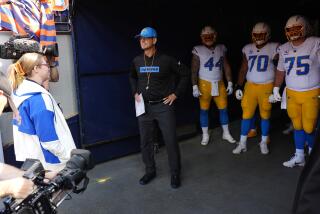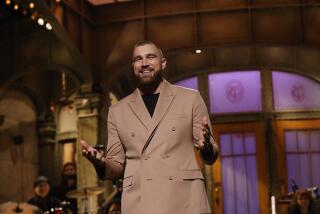There’s No Guarding Against Injuries
- Share via
It is The Moment, a frightening split-second misstep that can cost an athlete his or her career, or worse. It is one of the most feared and least-talked-about aspects of professional sports. One moment can bring a broken bone or shredded cartilage or fractured ego that erases all the years spent training to be physically and emotionally strong. The Moment is when a life is redefined, in which the very pursuit of excellence can send an athlete into an uncontrolled spin toward retirement.
--Darryl Stingley, a 26-year-old wide receiver for the New England Patriots, was running a 14-yard slant pattern during an exhibition football game against the then-Oakland Raiders on Aug. 12, 1978, when he was hit in the head by Jack Tatum, sending Stingley’s neck snapping back. He was left a quadriplegic.
--A baseball toddler at 24, Cleveland Indians pitcher Herb Score appeared to be well on his way to greatness, the fastest gun in baseball in 1957. Then Gil McDougald of the New York Yankees hit a line drive--some at the scene estimated the ball traveled between 80 and 100 m.p.h.--off the right eye of Score.
There are few occupations in which, simultaneously, the rewards are so rich and the dangers so great as professional athletics. Yes, many athletes swim in money. Yes, a few are greedy. Yes, one contract can take care of a player for life. The average salary of the top 12 players on each NFL team (including incentives) is $710,000, and Raghib “Rocket” Ismail recently signed a four-year, $26.2 million contract with the Toronto Argonauts of the Canadian Football League. Ismail wanted most of his contract to be guaranteed ($18.2 million of it is), so he would have money for his family and himself should tragedy strike.
And occasionally it does.
“Of the athletes that make the really big money -- and there are only a few of them -- almost none ever make the big money forever,” said Donald Fehr, executive director of the Major League Baseball Players Association. “So the athletes try to get as much as they can before it all ends. Sometimes it ends before they want it to.”
The list of the fallen is long. One of the more famous names on it is that of Bo Jackson, the two-sport superstar who fostered an image through Nike television commercials that you can do anything you want. But Jackson -- who plays football for the Raiders and baseball, if he comes back, for the Chicago White Sox -- was felled by a routine tackle during an AFC playoff game against the Cincinnati Bengals last season.
Millions of TV viewers saw Jackson’s left leg yanked from behind by linebacker Kevin Walker after a 34-yard run, then watched Jackson get helped off the field.
That one hit -- the play must have lasted about eight seconds -- led to cartilage damage in the hip socket, with the destruction so acute (much of the cartilage has wasted away) that Jackson may never play baseball or football again.
The list goes on:
Boston Red Sox outfielder Tony Conigliaro was the youngest player to lead the majors in home runs and the youngest to reach 100 home runs. At 19, he made his Fenway Park debut by smashing a pitch into the stands. But on Aug. 18, 1967, he was beaned by California Angels pitcher Jack Hamilton, resulting in a broken cheekbone, a dislocated jaw and a damaged retina in his left eye. He returned but was never the fearsome hitter he once was. Conigliaro lapsed into a coma in 1982 after suffering a massive heart attack and died eight years later.
“We really try to drive home to our the players that their life is a rewarding but rather precarious existence, and it can end rather abruptly,” said Dave Tucker, a psychologist who helps run a postcareer planning program for the National Hockey League. Along with counseling, the program, the only one of its kind in professional sports, assists many of those who have college degrees to complete when the games end.
And when they do, many of the athletes will be lucky to leave with their bodies and psyches whole. And those who don’t will always remember The Moment, as does Stingley, who said in a soft voice: “There hasn’t been a day that has passed where I don’t think about what could have been. I stopped asking myself why, but now it’s ‘what if.’ It’s not a denial thing with me. I am like this; I am a quadriplegic. It’s just that I wish I could have those couple of seconds back.”
ALWAYS THE NEXT GUY
No one ever thinks The Moment will come. It is always going to happen to someone else.
Tucker, through the NHL-sponsored program, would like to get athletes thinking about The Moment before it grabs them by the throat. The program costs the league about $70,000 annually, and, on a rotation basis, reaches anywhere from five to seven teams a year. It includes a three-hour seminar for players and wives that teaches them about life after hockey.
Tucker said he attempts to teach players “that the more outlets they can make for themselves now, the easier their life will be when the time to leave hockey comes. A lot of the issues we teach revolves around a sense of identity and self-worth. After being so passionately revolved around their sport, they need to learn other things so that when hockey is over they have other things to get them out of bed in the morning.”
In 1988, the group surveyed 300 NHL players (there are about 525 total) and 100 of those players’ wives. Results showed that the primary concern among the players upon voluntary or forced retirement were the “financial implications.” Social and family implications ranked second.
“Some of these athletes can’t engage in social sports and situations,” said Gerald Herz, a Washington-based attorney who has helped baseball, basketball, soccer and football players (including former Redskins quarterback Doug Williams) get workers compensation after being released from a team because of injury. “To do something like go out and play golf, they have to take Motrin.”
The third biggest concern, Tucker said, was emotional stress. “The void that’s left,” he said.
MIND IS UP TO THE TASK
“It seems to me that the more severe the injury, the more strength that person has to cope with it,” said Bubba Tyer, who has seen just about every injury imaginable as the Washington Redskins’ trainer for the past 14 years. “There is especially a certain calmness immediately after they get hurt. The more severe the injury, the more calm and rational they are. It seems your body kind of goes into shock a little bit. They get this look that says, ‘I guess my time has come.’ ”
“Fans and other people think players are asking for too much money,” said Stingley. “I don’t think they are being greedy at all. Every time you step out there, you stand a chance to never walk off. The money I’m receiving now could never be enough for what I lost. One of the reasons a lot of football players are asking for so much now is because of people like myself.”
Slowly, after fighting for his life because of lung complications, after a fire in his 12-story Chicago apartment building that nearly killed him (he was unhurt but “that was the second time I was lucky to be alive”), Stingley is concentrating on living as normal an existence as possible. The NFL will pay him $1,000 a month and cover his medical bills for the rest of his life.
He is 39, and now helps charity groups in Chicago raise money for spinal cord injuries. There are numerous speaking engagements.
“It sort of changed everyone’s life around me,” Stingley said about his injury. “Family, friends, friends I thought were friends but really weren’t. It touched just about anyone that knew me well.
“The biggest thing for me was the day I stopped asking myself the reasons why. I started living again.”
More to Read
Go beyond the scoreboard
Get the latest on L.A.'s teams in the daily Sports Report newsletter.
You may occasionally receive promotional content from the Los Angeles Times.










